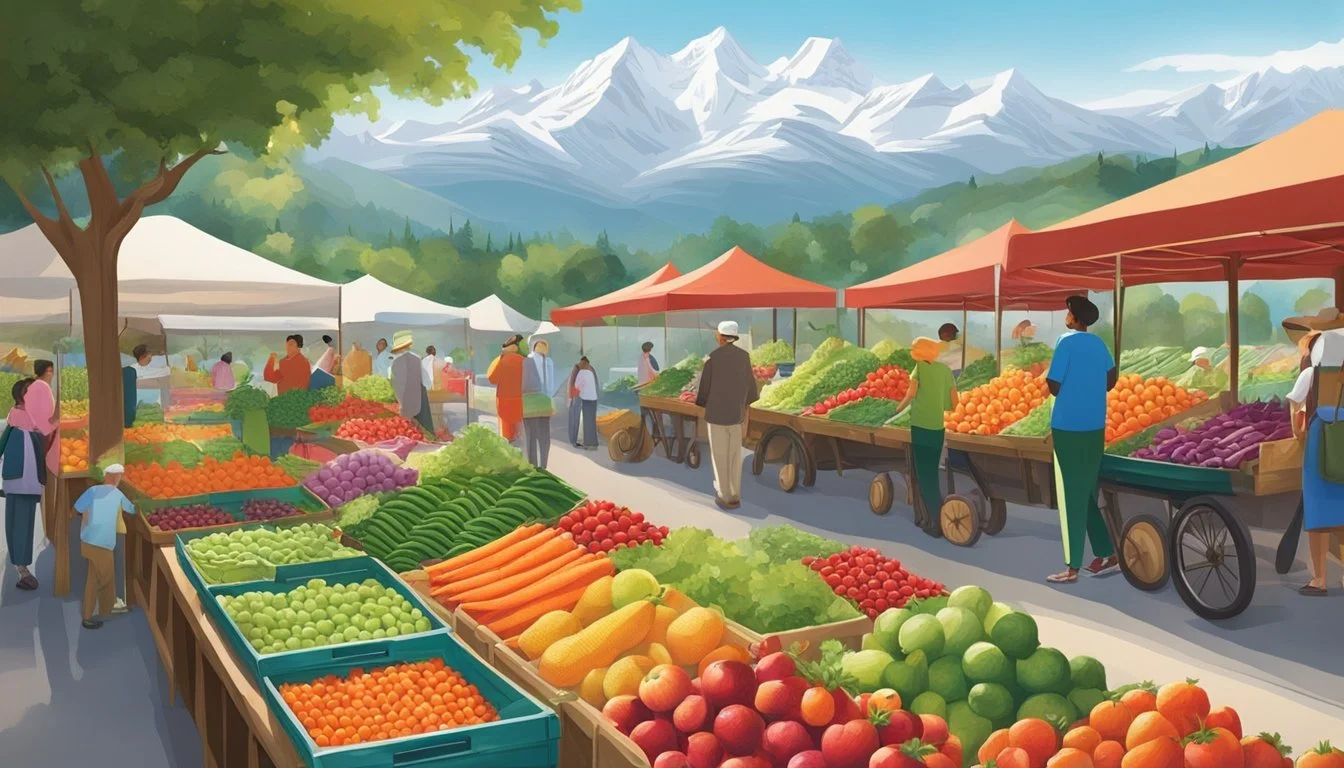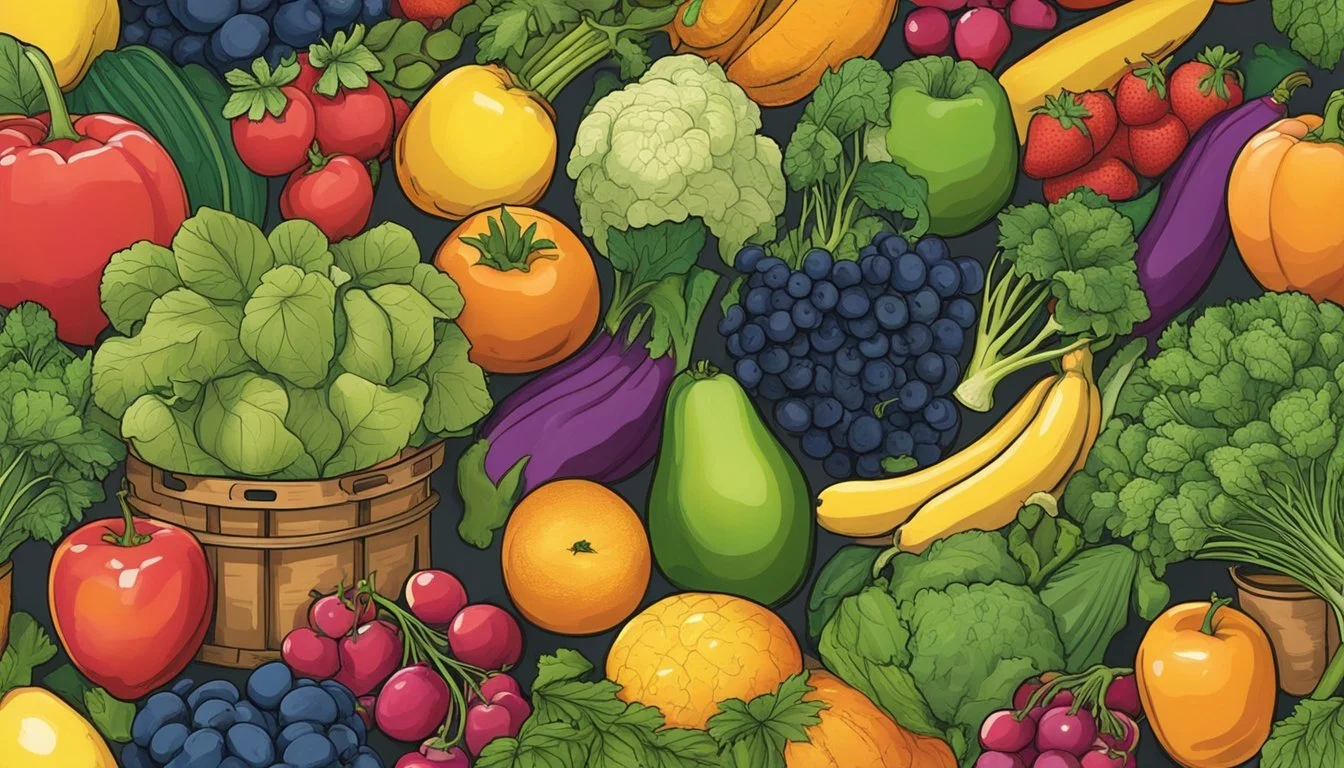Alaska Seasonal Fruit & Vegetables in April
Your Guide to Fresh Produce
This Article is Part of our Alaska Seasonal Fruit & Veg Calendar
Alaska's unique climate and extended daylight hours during the growing season yield an array of seasonal produce, each coming to harvest at different times of the year. In April, while much of the state still emerges from winter's hold, local farms and gardens begin to offer the first signs of spring through the produce that can withstand the cooler temperatures.
Seasonal vegetables available from local sources in April include a variety of root vegetables and hearty greens. Beets and carrots, often stored in cold storage from the previous year's harvest, remain staples on the Alaskan table. Radishes add a peppery crunch to dishes, and onions, a fundamental ingredient in countless recipes, are readily accessible. Rhubarb, with its tartness, also makes its debut and is commonly used in pies and preserves, heralding the coming of more diverse produce as the season progresses.
Overview of Alaska's Seasonal Produce
In Alaska, the rhythm of the seasons significantly influences the availability and flavor of local produce. Understanding the state's harvest calendar enhances the consumption of fresh, nutrient-rich foods.
The Importance of Seasonality
Seasonality plays a crucial role in the agricultural output of Alaska. Spring and summer yield the longest days, prompting a burst of growth that leads to vibrant, flavor-rich produce. Fall sees the harvest of heartier vegetables before the deep winter sets in, during which fewer fresh local options are available. Eating seasonally ensures one enjoys fruits and vegetables at the peak of their flavor and nutritional value, supporting the local economy and reducing food miles.
Alaska's Unique Growing Conditions
Alaska's growing conditions are distinct due to its high latitude and climate variation. The state experiences an accelerated growing period during spring and summer months, with extended daylight hours facilitating intense periods of photosynthesis. This results in some of the most flavorful produce, as crops like berries and root vegetables rapidly mature. Conversely, during the fall and winter, the selection of in-season produce dwindles, and the focus shifts to stored harvests and hardy greens that can withstand colder temperatures.
April's Harvest Calendar
April in Alaska presents a unique and limited selection of fresh produce due to its climate. Vegetables are starting to make their appearance with a focus on hardy greens and root vegetables that can tolerate the cooler temperatures.
Vegetables in Season
Greens: Alaskans can enjoy a variety of cold-hardy greens such as:
Kale: (What wine goes well with kale?) Versatile for salads and cooking.
Spinach: Tender and perfect for fresh salads.
Root Vegetables: Early-sown root vegetables make their way into the season:
Radishes: Crisp with a peppery kick.
Carrots: Sweet and can be eaten raw or cooked.
Other Vegetables:
Cabbage: An excellent base for slaws and ferments.
Cauliflower: Great for roasting or as a low-carb substitute.
Potatoes: Comforting and diverse in culinary uses.
Onions: A foundational ingredient in many dishes.
Fruits in Season
Rhubarb: Technically a vegetable but often treated as a fruit in culinary uses, it is one of the first to make an appearance in the season.
April in Alaska may not offer the wide range of produce found in warmer climates, but the available vegetables and fruits are cherished for their freshness and the promise of the coming growing season.
Preparing and Storing April's Produce
As the Alaskan growing season begins, proper handling and storage of April's produce is vital for maximizing freshness and flavor. Knowing how to care for these items ensures they remain nutritious and delicious until they're ready to be enjoyed.
Storage Tips
Asparagus (What wine goes well with asparagus?): Store them upright in a glass of water, trimming the ends, and loosely cover with a plastic bag before refrigerating. The freshness typically lasts for a week.
Spring Onions: Place them in a perforated plastic bag in the vegetable drawer of the refrigerator. They can last up to two weeks when stored properly.
Romaine Lettuce: Keep it dry and wrapped in paper towels inside a plastic bag in the fridge to prevent wilting. Consume within one week.
Rhubarb: Wrap in a damp towel and place it in a plastic bag in the crisper. It should stay fresh for up to two weeks.
Freezing and Preservation
Asparagus and peas can be blanched for one to two minutes, plunged into ice water to stop the cooking process, drained, and then placed in airtight containers or freezer bags before freezing.
Spring onions and herbs can be finely chopped, placed in an ice cube tray, covered with water, and frozen; they’re then ready to be used as flavor enhancers in cooking.
Rhubarb may be diced and spread on a baking sheet to freeze individually. After they are frozen, transfer to a freezer-safe bag for long-term storage.
Care with harvest, immediate storage, and appropriate preservation methods, such as freezing, are crucial steps for maintaining the integrity and taste of April's Alaskan produce.
Health Benefits and Nutrition
Consuming seasonal produce like fruits and vegetables is inherently beneficial for health. Alaskan fruits and vegetables in April provide essential vitamins and minerals which are crucial for overall health maintenance. Fruits that one might find in this period include berries as well as greenhouse-grown options that are packed with antioxidants.
Greens and vegetables become more readily available, including the likes of kale and cabbage, which are rich in fiber and vital nutrients such as vitamin C and K. Introducing these vegetables into one’s diet supports heart health and aids in digestion.
The consumption of seasonal produce also ensures a diverse intake of phytonutrients, which can help in reducing inflammation and enhancing the body's immunity—important factors during the lingering cold months.
Nutrient Benefits Found in Vitamin C Boosts immune system Berries, Kale Vitamin K Improves bone health Greens, Cabbage Fiber Supports digestive health Root vegetables
It is important to note that the nutritional profiles of fruits and veggies vary. For instance, root vegetables that can store well over winter, such as carrots, provide beta-carotene, which the body converts into vitamin A, essential for eye health.
By incorporating a mixture of Alaskan produce into one’s diet, individuals take a step towards balanced nutrition, further leading to a healthier lifestyle. Its restricted growing season enhances the value of each item, making April a prime time to enjoy the fresh taste and nutritional benefits of local fruits and vegetables.
Alaskan Gardening Tips for April
In April, Alaskan gardeners must prepare for the growing season ahead. They face unique challenges including cold temperatures and soil that needs special care.
Understanding the Soil
In Alaska, soil quality varies and often lacks essential nutrients due to the cold climate which inhibits decomposition. Gardeners should:
Test the soil to identify deficiencies and amend it with the necessary nutrients.
Consider raising the beds or using containers to manage temperature and drainage more effectively.
The short growing season in Alaska necessitates rapid soil warming. Gardeners may cover the soil with black plastic to attract more heat or mix in organic matter to enhance warmth and nutrient levels. After the danger of frost has passed, transferring young plants outside will be more successful in well-prepared soil that has been appropriately amended and warmed.
Dealing with Pests and Disease
Pests and disease can be particularly challenging in April due to the introduction of new plants into the garden, which can carry unwanted visitors.
To mitigate these issues, gardeners should:
Inspect new plants carefully before introducing them to the garden to avoid disease and pests.
Implement crop rotation to reduce disease carryover from previous years.
Utilize natural remedies like neem oil or diatomaceous earth to control pest populations without harming the environment.
Recipes and Cooking Ideas
April in Alaska brings about an assortment of fresh produce that can be transformed into delicious, hearty meals. Utilizing seasonal vegetables not only enhances the flavor of dishes but also ensures the freshest ingredients are at hand.
Asparagus, a spring favorite, shines in a variety of recipes. It can be grilled with a touch of olive oil and lemon zest for a simple side, or incorporated into a creamy Spring Vegetable Lasagna, which also showcases other in-season vegetables like carrots.
Speaking of carrots, they add a crisp sweetness to dishes and can be roasted to concentrate their natural sugars or shredded into a vibrant salad when raw. Combine them with a medley of other seasonal vegetables such as radishes for a crunchy texture and peppery bite.
When it comes to fruit, strawberries can be found ripening at this time, and they make for an excellent base in desserts. A Strawberry Cobbler captures their juicy essence, making for a delightful treat that balances the sweetness of the berries with a buttery topping.
Alaskan Produce Recipes Asparagus Grilled Asparagus (What wine goes well with grilled asparagus?), Spring Vegetable Lasagna Carrots Roasted Carrots, Carrot and Radish Salad Radishes Radish Salsa, Mixed Vegetable Pickles Strawberries Strawberry Cobbler, Fresh Strawberry Salad
For those enjoying the crispness of Alaskan greens, a fresh kale salad tossed with a light vinaigrette can be invigorating. A more robust option could be kale chips, baked till crispy, seasoned lightly with sea salt (how long does sea salt last?).
Creative use of Alaska's seasonal produce in April can lead to a delightful array of dishes, from light and fresh to warm and comforting, always ensuring that the essence of the ingredients' flavors is front and center.
Where to Find Local Produce in April
During April in Alaska, finding fresh, local produce requires knowledge of seasonal availability and where to look. Consumers seeking the freshest ingredients can turn to various venues across the state.
Farmers Markets: Several markets start early in the year, offering a selection of cool-season crops. They are a reliable source for locally-sourced produce such as greens and root vegetables.
South Anchorage Farmers Market: Known for early openings, it's a great spot for spring vegetables.
Fairbanks Farmers Market: Offers a variety of locally grown produce that starts to thrive in the colder months.
Community Supported Agriculture (CSA): Participating in a CSA can provide a steady stream of produce during the Alaskan early growing season.
Abby Ala's Farm: Operating a CSA program with pick-ups starting in June, it may have early offerings of overwintered crops.
Local Farms: Some farms begin to sell early produce directly to consumers in April.
Kenai Produce Farm: Opens for direct sales and may offer early harvest items such as greenhouse-grown herbs.
Venue Type Example Location Notes Farmers Markets South Anchorage Market Open for early vegetable crops CSA Programs Abby Ala's Farm Possible early pick-ups Local Farms Kenai Produce Farm Direct sales, check for availability
For the most up-to-date information on produce availability, consumers should consult local resources or directly contact farms and markets. With limited operations due to the season, it's advisable to verify opening dates and times.
Community and Agricultural Events in April
In April, Alaska's community and agricultural events begin to embrace the spring thaw, offering a variety of activities centered on the state's unique growing season and local produce.
Farmers' Markets
As the state thaws, farmers' markets start to open their stalls with early-season crops. Visitors and locals can find an array of fresh, locally-grown produce that includes:
Cold-tolerant greens such as kale and chard
Root vegetables like turnips and radishes
Variety of greenhouse-grown herbs
Seed Swaps and Gardening Workshops
Seed swaps become a focal point for communities looking to share heritage seeds adapted to the Alaskan climate. These events, along with gardening workshops, provide valuable learning opportunities about sustainable practices suited to the region.
Community Supported Agriculture (CSA)
Alaskan CSAs often kick off in April, where community members can subscribe to receive a share of the upcoming harvests from local farms. This initiative strengthens community-farmer relationships and supports the local agricultural economy.
Earth Day
Earth Day celebrations highlight the importance of agriculture in sustaining local communities and the planet. Festivals, clean-ups, and educational events are commonplace, drawing attention to ecological farming and responsible consumption.
Event Type Description Farmer's Markets Stalls with fresh, local produce open for the new season. Seed Swaps Exchange of local heritage seeds among the community. Gardening Workshops Educational sessions on cold-climate growing techniques. CSA Subscriptions Begin Community members can start receiving shares of local farms. Earth Day Celebrations Events focused on ecological awareness and sustainability.
Local communities are instrumental in these events, which celebrate the onset of the growing season and foster a connection with the environment and local food systems.
Looking Forward to Summer Produce
As the Alaskan summer approaches in June, anticipations for the seasonal harvest begin to rise. The state's daylight increases significantly, allowing a unique array of produce to flourish. In particular, strawberries emerge as a star fruit during the Alaskan summer. The long hours of sunshine allow these berries to develop a rich, concentrated flavor that is eagerly awaited by both locals and culinary enthusiasts.
Summer also brings a bounty of peas, another cooler-weather crop that thrives in the Alaskan climate. Fresh, sweet, and perfect for a range of dishes, peas harvested in summer can be enjoyed straight from the pod or incorporated into salads and entrees.
Table: Anticipated Summer Produce in Alaska
Produce Availability Notes Strawberries Early to mid-June Known for their vibrant flavor Peas June Celebrated for their sweetness
Gardeners and farmers work diligently through the spring months to prepare for the summer yield. Consumers can look forward to these treasures at local markets, heralding a season of fresh, vibrant flavors that capture the essence of Alaskan summer.
Conclusion
In Alaska, April signifies a transitional period for produce, as winter's hold begins to loosen and the first signs of spring herald the arrival of a new growing season. Those seeking to enjoy fresh, seasonal foods can anticipate a variety of produce coming into availability.
Key Vegetables:
Kale
Carrots
Emerging Fruits:
Rhubarb (late April)
At this time, root vegetables like carrots continue to be found with vigor, providing a crisp and nutritious option for consumers. Leafy greens such as kale, favored for their hardiness and health benefits, are also typically accessible.
Rhubarb, though not a fruit by botanical standards, is often the first "fruit" of the season and starts appearing by late April. It's a versatile ingredient embraced by chefs and home cooks for its tart flavor, suitable for both sweet and savory dishes.
Alaskans passionate about culinary experiences that honor the rhythm of nature often find April an exciting month. With the landscape thawing, the region’s agricultural endeavors begin to sow seeds for the forthcoming abundance of summer. As one savors the last of winter's bounty and looks forward to spring's awakening, April stands as a testament to Alaska's resilient and bountiful nature.
For those investigating local and seasonal eating, the foods available during this month offer a glimpse into sustainable food practices within Alaska’s distinctive climates.











